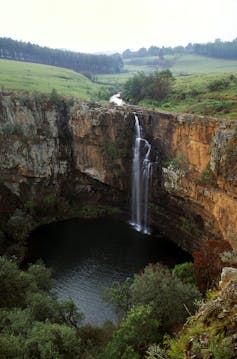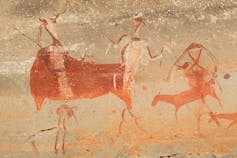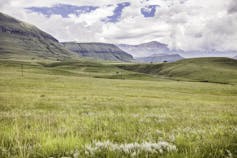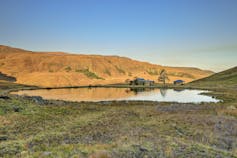South Africa’s Drakensberg mountains have a new 6,500 hectare nature reserve. The new Northern Drakensberg Nature Reserve is working with communities and will preserve ancient rock art, vital grasslands and water sources for millions of people. It connects a neighbouring world heritage site to another nature reserve, expanding a huge transnational protected area from South Africa to neighbouring Lesotho.

Most importantly, it will open a new and important wildlife migration corridor. Migratory animal populations will be able to recover as they’ll no longer be isolated and fragmented.
It took six years for landowners and conservationists to get the new park formally declared, much faster than it usually takes to have land declared protected. It was only possible due to a high degree of consensus among landowners that a commitment to conservation was the best way to manage their land for future generations.
I research how land and ecological systems are governed across boundaries. I believe the new reserve takes forward a commitment made by South Africa at the COP15 biodiversity conference in 2022 that it would protect 30% of its land (including mountains) and oceans by 2030.

So far, only 9.2% of South Africa’s land is under protection, and biodiversity loss is increasing. This is why strategic additions to protected areas are particularly important.
Nearly 20% of water in the Vaal river system originates in the Northern Drakensberg – in other words, the Northern Drakensberg supplies water for about four million people. The way water is managed at the source matters for everyone who will eventually use the water.
A remote and magical place
The greater Drakensberg protected areas include a broad mountainous region that stretches all along the eastern border between South Africa and Lesotho, from the northernmost tip near Phuthaditjhaba at the Golden Gate Highlands National Park, to the southern tip near Mount Fletcher.
It also includes wetlands and grasslands, and some of the best rock art in the world, with over 600 sites dating back as far as 3000 BC.

There are many historical sites in the area that are yet to be explored by archaeologists, such as iron smelters, and places where tools have been discovered that date back more than 25,000 years. It’s sparsely populated, with single farms often comprising more than 2,000 hectares.
Much of the Northern Drakensberg is difficult to reach apart from on foot. It is full of dramatic rock formations, and home to wildlife such as endangered vulture colonies, herds of eland and other grassland animals that benefit from expanded migratory corridors. It is an attractive tourism destination for hikers, birders and people who are looking for wildness experiences.
Why has a new nature reserve been declared there?
Water: It is an important high altitude water catchment area. It straddles the border of the Orange River basin – the largest water resource in South Africa – and the smaller catchments that flow into the Indian Ocean. Protecting water sources in the Drakensberg allows people to have clean tap water. Maintaining pristine water quality in this area is tremendously important.

Grasslands: These cover the Drakensberg mountains, and serve many important functions, such as absorbing water during times of heavy rainfall and releasing it slowly throughout the year. Grasslands are also a carbon sink in ecosystems. Only 2% of grasslands are under formal protection in South Africa.
The grasslands in the new nature reserve include some of the country’s most endangered vegetation types, such as the Income Sandy Grassland and the Mabela Sandy Grassland. Nearly half of South Africa’s endemic mammals are found in grasslands. Four are endemic to this landscape alone: the black wildebeest, rough-haired golden mole, Natal red rock rabbit and Sloggett’s rat. The area is also home to a large number of endangered bird species that are found nowhere else.

Communities: The reserve takes a new approach to conservation, by integrating environmental protection with ongoing economic activities. It works with communities, instead of excluding them from the protected area. The hope is that the new park will increase economic activities locally, such as agriculture, tourism and natural resource beneficiation, such as using reeds and grasses to make mats and baskets.
The creation of the new reserve was driven by dedicated, conservation-minded land owners, who shared a vision of conservation and economic development. They witnessed corporations taking over farms and commercialising them with forestry. Most residents in the area were committed to finding a model for more sustainable development.
Transnational protected corridor: The Northern Drakensberg Nature Reserve connects the Maluti Drakensberg Transfrontier Conservation Area to southern grazing lands. Soon, conservationists hope, there will be a continuous protected area across the Drakensberg.
Why it matters
South Africa has so many unique ecological resources that need different kinds of involvement and protection, whether it is urban green spaces, individual critically endangered species that benefit from citizen science and awareness raising, or the governance of our just energy transition.
The new Northern Drakensberg Nature Reserve is a small but important step forward. Land owners, local government and civil society have come together take positive steps towards better land governance.

